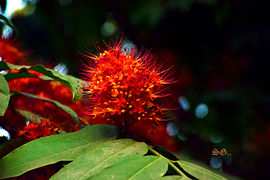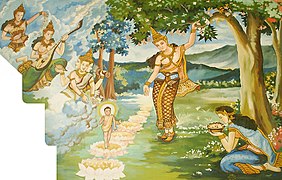Saraca asoca
| Ashoka tree | |
|---|---|

| |
| Ashoka flower cluster | |
| Scientific classification | |
| Kingdom: | Plantae |
| Clade: | Tracheophytes |
| Clade: | Angiosperms |
| Clade: | Eudicots |
| Clade: | Rosids |
| Order: | Fabales |
| Family: | Fabaceae |
| Genus: | Saraca |
| Species: | S. asoca
|
| Binomial name | |
| Saraca asoca | |
| Synonyms[2] | |
Saraca asoca, commonly known as the ashoka tree (lit. "sorrow-less"), is a plant belonging to the Detarioideae subfamily of the legume family.[3] It is an important tree in the cultural traditions of the Indian subcontinent and adjacent areas. It is sometimes incorrectly known as Saraca indica.[4] The flower of Ashoka tree is the state flower of Indian state of Odisha.[5]
Description
The ashoka is a
The ashoka is prized for its beautiful foliage and fragrant flowers. It is a handsome, small, erect evergreen tree, with deep green leaves growing in dense clusters.
Its flowering season is around February to April. The ashoka flowers come in heavy, lush bunches. They are bright orange-yellow in color, turning red before wilting.
As a wild tree, the ashoka is a vulnerable species. It is becoming rarer in its natural habitat, but isolated wild ashoka trees are still to be found in the foothills of the central and eastern Himalayas, in scattered locations of the northern plains of India as well as on the west coast of the subcontinent near Mumbai.[citation needed]
There are a few varieties of the ashoka tree. One variety is larger and highly spreading. The columnar varieties are common in cultivation.
-
Leaves and flowers in Kolkata, West Bengal, India
-
Ashoka blossom
Mythology and tradition
The ashoka tree is considered sacred throughout the Indian subcontinent, especially in India, Nepal and Sri Lanka. This tree has many folklorical, religious and literary associations in the region. Highly valued as well for its handsome appearance and the color and abundance of its flowers, the ashoka tree is often found in royal palace compounds and gardens as well as close to temples throughout India.[6]
The ashoka tree is closely associated with the
Yakshis under the ashoka tree were also important in early Buddhist monuments as a decorative element and are found in many ancient Buddhist archaeological sites. With the passing of the centuries the yakshi under the ashoka tree became a standard decorative element of Hindu
In Hinduism the ashoka is considered a sacred tree. Not counting a multitude of local traditions connected to it, the ashoka tree is worshipped in Chaitra,[9] a month of the Hindu calendar.[9] It is also associated with Kamadeva, the Hindu god of love, who included an ashoka blossom among the five flowers in his quiver, where ashoka represent seductive hypnosis.[10] Hence, the ashoka tree is often mentioned in classical Indian religious and amorous poetry, having at least sixteen different names in Sanskrit referring to the tree or its flowers.[11]
In Mahākāvya, or Indian epic poetry, the ashoka tree is mentioned in the Ramayana in reference to the Ashoka Vatika (garden of ashoka trees) where Hanuman first meets Sita.
-
Dried ashoka flower (Saraca asoca) for selling in Kolkata market, India
-
Queen Māyā giving birth to the Buddha
-
Yakshi under a stylized ashoka tree. Railing figure at Bharhut Stupa, 2nd century BC, India.
Other trees called 'ashoka tree'

A popular tree known as "false ashoka tree" or even as "ashoka tree",
Uses
The bark of the ashoka plant is mixed with fourteen other herbs like
See also
- Indian epics
- Kurincippattu
- Shitala
- The birth of Buddha (Lalitavistara)
References
- ^ CAMP Workshops on Medicinal Plants, India (1998). "Saraca asoca". IUCN Red List of Threatened Species. 1998: e.T34623A9879360. Retrieved 2 June 2023.
- ^ a b "Saraca asoca (Roxb.) Willd. — The Plant List". The Plant List. 5 January 2015.
- PMID 29720687.
- ^ Zuijderhoudt, G.F.P. (1968), "A revision of the genus Saraca L. — (Legum. Caes.)", Blumea, 15: 413–425
- ^ Orissa State Symbols
- ^ "Herbs - Ashoka". Tamilnadu.com. 25 February 2013. Archived from the original on August 14, 2013.
- ^ Heinrich Zimmer, Myths and Symbols in Indian Art and Civilization. (1946)
- ISBN 978-3-424-00897-5
- ^ a b "Ashoka Tree". Archived from the original on 2011-07-11. Retrieved 2009-03-30.
- Bombay: THACKER and Co. Ltd. p. 5.
- ISBN 978-3-424-00898-2
- ^ "Ashokarishta Uses, Ingredients, Dosage and Side Effetcs and Price". bimbima. 6 July 2017. Retrieved 29 July 2022.
Further reading
- Saha, Jayita; Gupta, Kamala; Gupta, Bhaskar (January 2015). "Phylogenetic analyses and evolutionary relationships of Saraca asoca with their allied taxa (Tribe-Detarieae) based on the chloroplast matK gene". Journal of Plant Biochemistry and Biotechnology. 24 (1): 65–74. S2CID 18464425.
External links
 Media related to Saraca asoca at Wikimedia Commons
Media related to Saraca asoca at Wikimedia Commons






